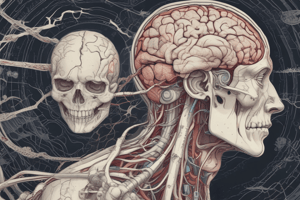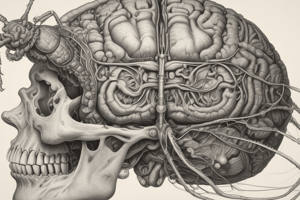Podcast
Questions and Answers
What are the three main parts of the brain?
What are the three main parts of the brain?
- Cerebrum, Brainstem, and Frontal Lobe
- Cerebrum, Cerebellum, and Spinal Cord
- Cerebellum, Brainstem, and Medulla Oblongata
- Cerebrum, Cerebellum, and Brainstem (correct)
What type of neurons transmit information from the central nervous system to muscles and glands?
What type of neurons transmit information from the central nervous system to muscles and glands?
- Motor neurons (correct)
- Glial cells
- Interneurons
- Sensory neurons
What is the function of the cerebellum in the brain?
What is the function of the cerebellum in the brain?
- Detecting stimuli from the environment
- Coordination and balance (correct)
- Controlling automatic functions such as breathing and heart rate
- Higher cognitive functions
What is the main function of the brainstem?
What is the main function of the brainstem?
What are the basic building blocks of the nervous system?
What are the basic building blocks of the nervous system?
What type of neurons detect stimuli from the environment and transmit information to the central nervous system?
What type of neurons detect stimuli from the environment and transmit information to the central nervous system?
What is the main function of the autonomic nervous system?
What is the main function of the autonomic nervous system?
What type of nerve cells transmit information from the central nervous system to muscles and glands?
What type of nerve cells transmit information from the central nervous system to muscles and glands?
What is the main difference between the sympathetic and parasympathetic systems?
What is the main difference between the sympathetic and parasympathetic systems?
Which type of glial cells provide structural support, insulate neurons, and produce various signaling molecules?
Which type of glial cells provide structural support, insulate neurons, and produce various signaling molecules?
What is the main function of interneurons?
What is the main function of interneurons?
What is the main component of the central nervous system?
What is the main component of the central nervous system?
Study Notes
Neurobiology: Understanding the Brain and Nervous System
Introduction
Neurobiology is the scientific study of the structure, function, and behavior of the nervous system. It involves the investigation of the brain, neurons, and the nervous system as a whole. The field of neurobiology encompasses various subtopics, including brain anatomy, neurons, the nervous system, branches of the peripheral nervous system, branches of the autonomic nervous system, types of nerve cells, types of glial cells, and much more. In this article, we will delve into these subtopics, providing a comprehensive overview of the fascinating world of neurobiology.
Brain Anatomy
The brain is a complex organ that plays a crucial role in controlling the body's functions. It is divided into three main parts: the cerebrum, the cerebellum, and the brainstem. The cerebrum is responsible for higher cognitive functions, the cerebellum for coordination and balance, and the brainstem for controlling automatic functions such as breathing and heart rate.
Neurons
Neurons are the basic building blocks of the nervous system. They are specialized cells that transmit electrical signals throughout the body. Neurons can be classified into three main types: sensory neurons, motor neurons, and interneurons. Sensory neurons detect stimuli from the environment and transmit information to the central nervous system. Motor neurons, on the other hand, send signals from the central nervous system to muscles and glands. Interneurons are found only in the central nervous system and connect one neuron to another, processing and integrating information.
Nervous System
The nervous system is a complex network of cells, fibers, and chemicals that coordinates the body's activities. It consists of the central nervous system (CNS) and the peripheral nervous system (PNS). The CNS includes the brain and spinal cord, while the PNS includes all the nerves outside the brain and spinal cord.
Branches of Peripheral Nervous System
The peripheral nervous system is further divided into the somatic nervous system and the autonomic nervous system. The somatic nervous system controls the contraction of skeletal muscles and the sensation of touch. It includes the motor neurons that control muscle movement and the sensory neurons that transmit information about touch, pressure, temperature, and pain.
The autonomic nervous system, also known as the visceral nervous system, regulates the body's internal organs and functions such as heart rate, blood pressure, and digestion. It is divided into the sympathetic and parasympathetic systems. The sympathetic system prepares the body for action, while the parasympathetic system restores the body to its normal state after the sympathetic system has acted.
Types of Nerve Cells
There are several types of nerve cells, including sensory neurons, motor neurons, and interneurons. Sensory neurons detect stimuli from the environment and transmit information to the central nervous system. Motor neurons send signals from the central nervous system to muscles and glands. Interneurons are found only in the central nervous system and connect one neuron to another, processing and integrating information.
Types of Glial Cells
Glial cells are a diverse group of cells that support, protect, and maintain the function of neurons. They can be broadly classified into two main categories: macroglia and microglia. Macroglia includes astrocytes, oligodendrocytes, and ependymal cells, which provide structural support, insulate neurons, and produce various signaling molecules. Microglia are the resident immune cells of the central nervous system, responsible for maintaining the central nervous system's homeostasis and responding to injury or disease.
Conclusion
Neurobiology is a fascinating field that explores the structure, function, and behavior of the nervous system. By understanding the brain, neurons, and the nervous system, we gain insights into the complex processes that control our thoughts, actions, and overall health. As research progresses, our understanding of the nervous system continues to grow, revealing new insights into the complex workings of the human body.
Studying That Suits You
Use AI to generate personalized quizzes and flashcards to suit your learning preferences.
Description
Explore the intricate world of neurobiology by learning about brain anatomy, different types of neurons, the nervous system, peripheral nervous system branches, and types of glial cells. Delve into the structure, function, and behavior of the brain and nervous system through this comprehensive overview.




